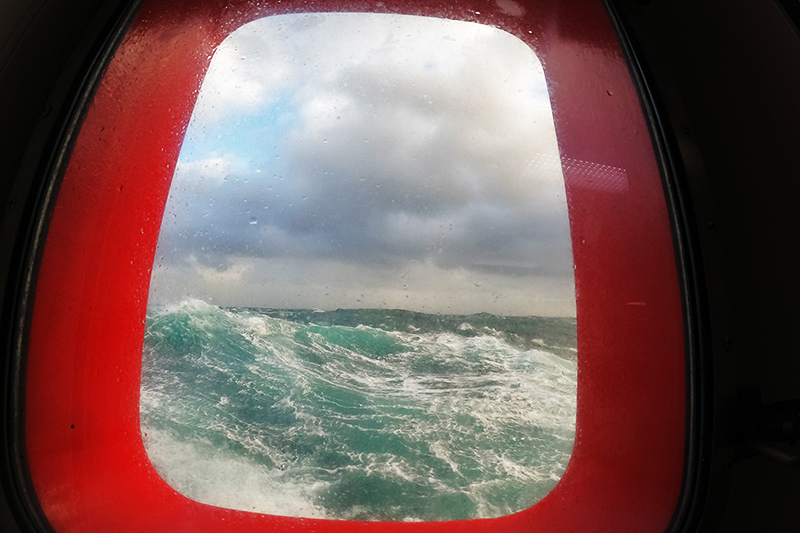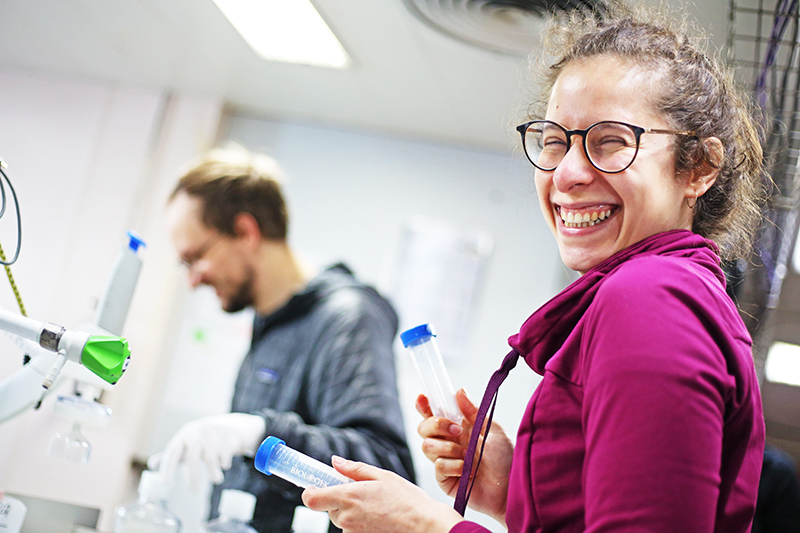Day 9: Hitting the wall
By Marley Parker
“Does anyone have an extra ratchet strap?” Erin Frates calls out to the room at large.
“I do!” Michelle Cusolito says.
With bad weather approaching, we are suspending science operations and hunkering down.
Co-lead scientist Heidi Sosik and a member of her lab, John San Soucie, test out different ways to secure the bank of computer screens for the instrument tow sled, StingRay. Other members of the science team race around the lab gathering loose objects — tools, hard hats, power cords, glasses, and water bottles. Everything must be tied down or crammed into a drawer.
Lead scientist Ken Buesseler sends pertinent reminders to the group:
Do take care moving around in your cabin, halls, common areas to have a hand (or two) free to hold railings. Be ready for unexpected rolls. We all want to get to the other side of this storm in good shape!
Over the next few days, we do our best to cope with the constant, dramatic motion of a heaving, rolling ship. Most of us don’t feel seasick – we feel exhausted. Activities as simple as opening a door or walking down the stairs require focused effort. To avoid rolling out of bed at night, we shove life jackets, sweatshirts, and rolled towels into our bunks and then wedge our bodies between them. We can’t make it through a meal without drinks spilling and plates sliding off the table. Loud, crashing noises become commonplace throughout the ship.
At lunch on Monday, I stare at my plate glumly. Michelle and Laetitia express concern, asking if I feel nauseous. “No, I’m not sick,” I say. “I just feel like I’ve hit a wall – mentally, physically, emotionally…”
“And literally!” WHOI biologist Joel Llopiz interjects from the end of the table.
It’s true. We have all been slamming into walls — in every sense — for three straight days now.
Despite most of our science operations being suspended, a few members of the team have continued to collect or process data.
John sets up automatic plankton identification, Alexi Shalapyonok tracks the continuous in-line sampling from the Imaging Flow Cytobot (IFCB), Henry Holm filters lipid samples, and Justin Ossolinski monitors the collection of seawater from the ship’s intake system.
I ask Justin how his equipment is faring in these conditions.
“It’s working great—surprisingly well, actually,” he says. “As long as I have seawater flowing, I’m still able to get bubble-free samples, which allows me to look at the dissolved gases.”
He explains that gathering data during stormy conditions gives the rest of the samples context.
“It’s valuable because we can see what’s happening in the storm, and also what happens as the waves dissipate and things return to previous conditions,” Justin says. “As we track changes through the storm, we can make some estimates about what the bugs might have been doing.”
After three days and four nights of relentless rough seas, Ken sends us a cautiously optimistic message on Tuesday night:
Hi all – more updates as the day progresses, but we are hoping as the conditions improve slowly, we’ll start to put equipment in the water… PLEASE continue to be careful moving about, keeping gear secured, and as we go back out on deck, be extra careful.
We’ve learned not to get our hopes up when it comes to the forecast. But over the course of the morning, we feel the swells slowly dissipate. At noon, we receive word that the CTD rosette is going in the water – and the energy on the ship immediately switches. The main lab, so sparsely populated during the storm, is now full of people.
As we watch the CTD rosette sink below the ship, the collective relief and excitement feels palpable. We are finally getting back to work.







